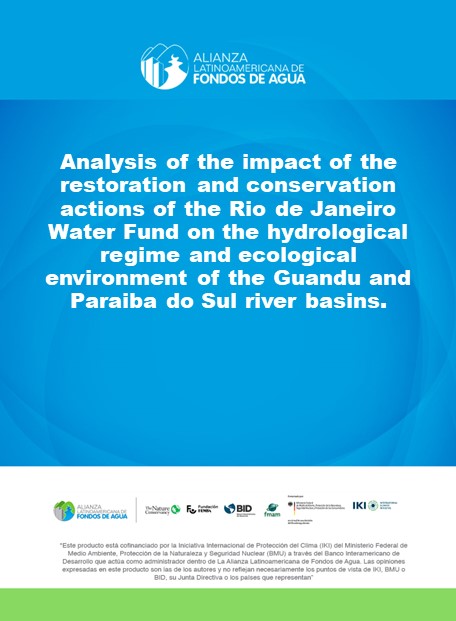Population pressure and the use of natural resources in the Rio de Janeiro state, plus the strong demand for water cause increasing changes in land use and coverage that affect water quality and generates a risk for the water security of the population of the state. The Rio de Janeiro Water Fund, an initiative that develops and improves financial and governance mechanisms to contribute to water security, has influenced the actions of nature-based solutions (NbS) in the hydrographic regions of the Guandu River and the Paraíba do Sul River. The study area comprises 7,420 hectares and the objective of the monitoring is to estimate how the effects of NbS (conservation, restoration, and natural regeneration) contribute to the reduction of sediments in water bodies, to the regularization of flow and to the maintenance or improvement of biodiversity compared to an area with natural vegetation, by using a reference-impact monitoring design. The monitoring was structured into three parts: (i) monitoring of land use and coverage and restoration, (ii) hydrological monitoring and (iii) biodiversity monitoring each with their specific methodology for data collection and analysis, considering data consistency and statistic trend tests. In the monitoring focus area, 46 ha were restored, 1785 ha were preserved, and another 356 ha of natural regeneration were identified inside and outside the participating project properties, while approximately 236 ha of native vegetation was lost in this area between 2009 and 2019, with only 16% of this total occurring within the participating project properties, which indicates that the project’s contribution was greater in reducing deforestation within participating properties than in directly increasing forest cover by restoration. The analysis shows a trend of significant decrease in rainfall over the years for the reference area only, however data shows a reduction of precipitation for both areas. Regarding flow, despite a slight increase between hydrological years 2018-2019, the reduction in flow is clear. This visual decrease is statistically detectable, according to the results of the Mann-Kendall test which indicate a trend of this reduction in both areas, which is also reflected in the also significant trend of decrease in rainfall in the region. Regarding biodiversity, the study shows a total of 303 species of birds registered which represents 37.9% of the species listed for the entire state of Rio de Janeiro, and also an increase of 10% of forest- dependent species.








